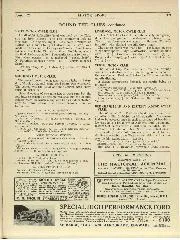
ROUND THE CLUBS, April 1926
ROUND THE CLUBS—continued. SCOTT MOTOR CYCLE CLUB. An all night Reliability Trial was held by the Club, starting from Barnet. The first competitor left at 7.30 p.m. During the night,…
* a * THE SINGER NINE Sir, I observe from the October Vintage Postbag yet another comment on Singer ears which can only be interpreted as adverse, and whilst pleased to see a champion of the ” Junior ” has appeared,
I would like to add a word in support of at least one of the subsequent 9-b..p. sports series.
Having been “brought up” on those most excellent though costly cars of Alvis, I was encouraged, by the considerable success Singers were having at the time, to purchase in 1934 a new 9-h.p. sports saloon. The car was standard except for a Le Mans engine installed at a nominal extra charge and also a ” Brooklands ” silencer— noisy exhausts were still the feature of sports cars in the mid-thirties.
The car has always been in daily use on countless long and short journeys except for basic-less periods and has had a really hard but not unkind life.
In 1945 came the first and only rebore with 88,000 on the clock, when the bores were made 20 thou. oversize and the crankshaft ovality of 4 thou. was eliminated. The present mileage is 103,000 and the general condition is such that the car should be good for many more miles without major attention, although the original cellulose no longer possesses Its showroom glint. I will refrain from quoting instances of average speeds which I fear would cause some scepticism. However, petrol con
sumption has always averaged 30-32 m.p.g., and oil consumption I deem negligible as topping-up between 1,500 mile changes of Castro’ X.L. (winter), or X.X.L. (summer). has been unnecessary. It is only fair to record that the sump capacity is 11 gallons.
On two occasions in the car’s early life, and consequent on fitting a thin gasket, the speedometer indicated 79 m.p.h. Although the genuine maximum is now only of the order of 64 m.p.h.. a comfortable cruising speed of 50-55, second and third gears which permit normal upward changes at 26 m.p.h. and 36 m.p.h., respectively, with plenty in reserve, and good brakes, roadholding and steering, all play their part in providing a performance that is not greatly inferior to many more modern medium h.p. cars. The fact that after 16 years the same car continues to give good service surely speaks for itself. It may be that as an engineer I have been better able to recognise and make due allowance for inherent weaknesses and limitations of design, and have given more than the average attention to routine maintenance. On the other hand, perhaps I have been just fortunate. Nevertheless, coupling my experience with the number of the series still on the road, that they are still represented with some success in local events, and the fact that the basic engine is reflected not only in the current Singer models but also in the H.R.G.,
I feel the 9-h.p. sports models were not as bad as they have so often been painted. am, Yours, etc.,
Pinner. W. J. WARD. * * *